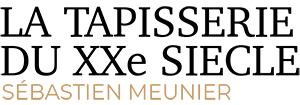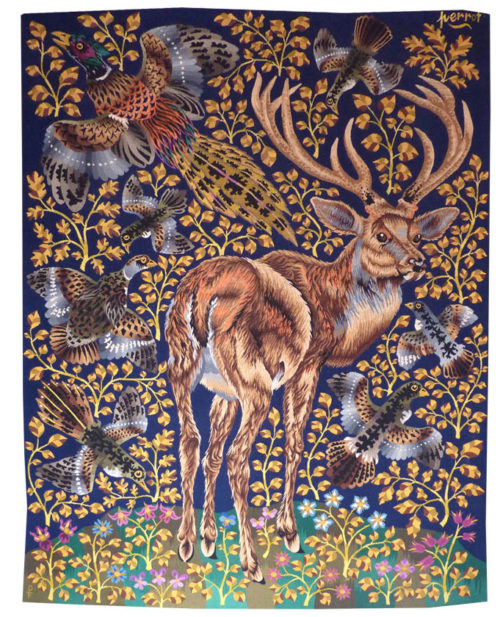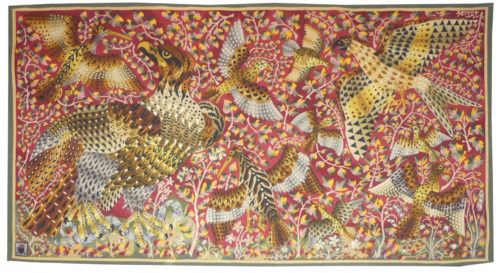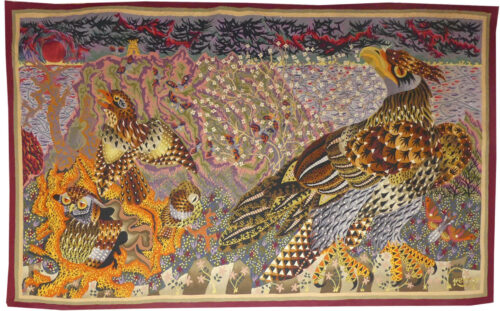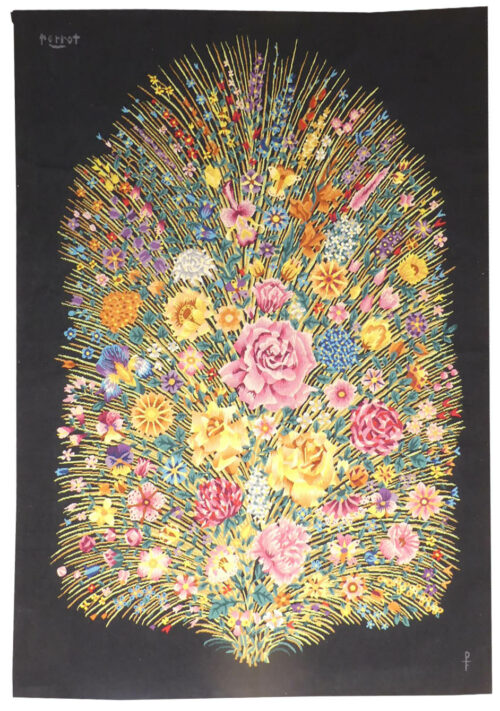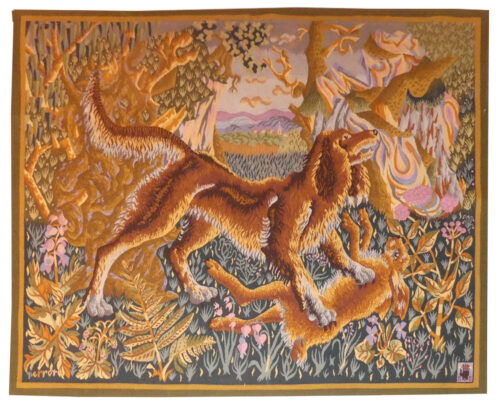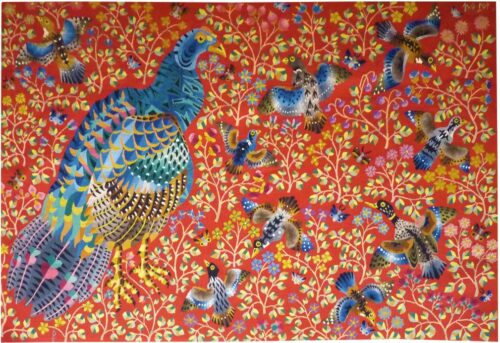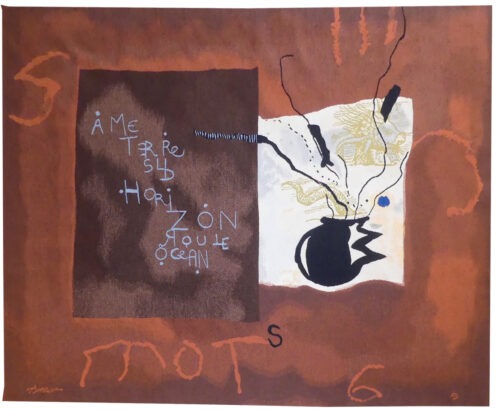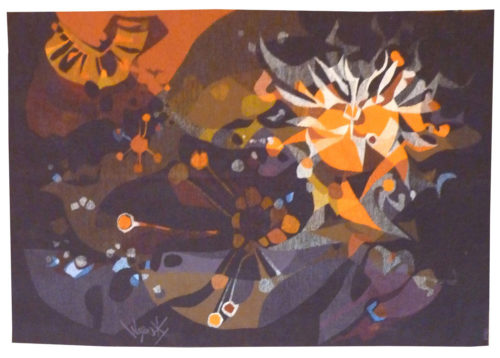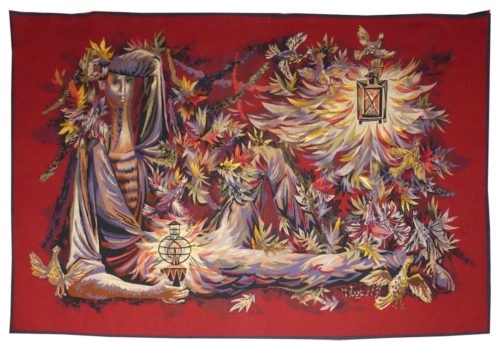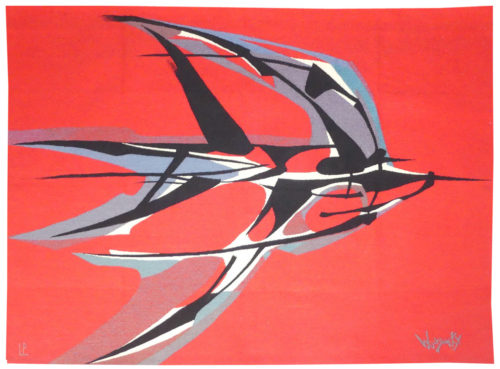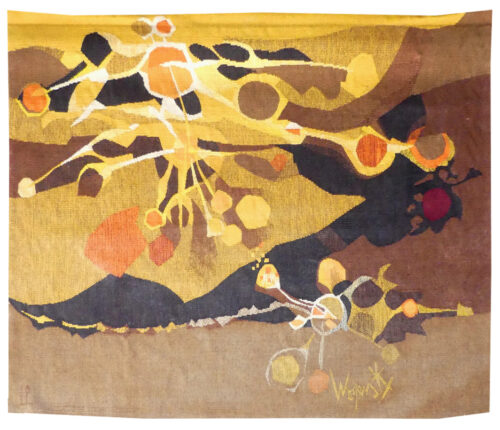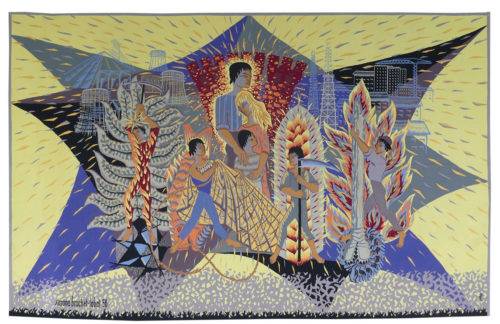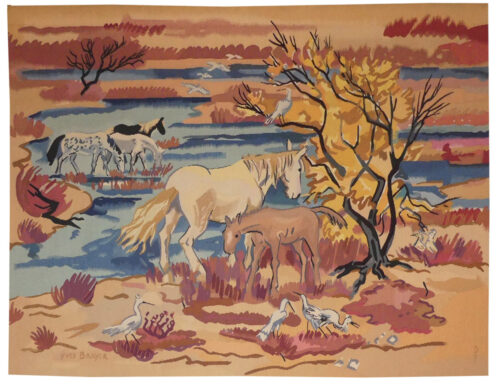-
Aubusson tapestry woven by the Rivière des Borderies workshop. With label. 1951.Perrot began his career as a cartoon designer at the end of the war, making almost 500 cartoons including numerous commissions from the state, most of which were woven at Aubusson. His style which is particularly rich and decorative is eminently recognisable : a crowd of butterflies or birds, most often, stands out against a background of vegetation, reminiscent of the millefleurs tapestries (which would also inspire Dom Robert). Ornithological representations in all their various manifestations are extremely common in Perrot’s work : for example “la discorde” and “la méditation” designed for the Palais de Justice (High Court) in Paris which are illustrated respectively by grouse and owls. What else to illustrate “La Loi” and inspire respect in the observor than the severe glare of a majestic eagle. Bibliography : Tapisseries, dessins, peintures, gravures de René Perrot, Dessein et Tolra, 1982
-
Oiseaux (birds)
Aubusson tapestry woven by the Tapisseries de France cooperative. 1952.Perrot began his career as a cartoon designer at the end of the war, making almost 500 cartoons including numerous commissions from the state, most of which were woven at Aubusson. His style which is particularly rich and decorative is eminently recognisable : a crowd of butterflies or birds, most often, stands out against a background of vegetation, reminiscent of the millefleurs tapestries (which would also inspire Dom Robert). If in Perrot's tapestries birds are often present (almost a trademark !) the use of landscape as a background is much rarer despite the artist having produced numerous works in gouache of his travels (Doubs, Auvergne, Collioure, the Canaries...), works which, despite their sensitivity, remain essentially little known. Bibliography : Tapisseries, dessins, peintures, gravures de René Perrot, Dessein et Tolra, 1982 -
Bouquet d'artifice (Bouquet of "flowerworks")
Aubusson tapestry woven by the Pinton workshop. Avec son bolduc signé de l'artiste. Circa 1960.First a poster artist, then an artist-ethnographer during the war, Perrot began his career as a cartoon designer at its end, making almost 500 cartoons, most of which were woven at Aubusson, including numerous commissions from the state (with 33 cartoons, Perrot is the most prolific tapestry designer in the Mobilier National’s collection!). His style which is particularly rich and decorative is eminently recognisable : he illustrates in flat colours (with neither shading nor picking) an abundance of animals (most often birds), standing out with no perspective, against a background of vegetation, in a style reminiscent of the mediaeval mille-fleurs tapestries. Rather like a floral display of pyrotechnics, « Bouquet d’artifice » (Bouquet of “flowerworks”) presents an abundant spray of numerous varieties, some even slightly stylised, in a riot of colours accentuated by the black background : an ode to Nature. Bibliography : Tapisseries, dessins, peintures, gravures de René Perrot, Dessein et Tolra, 1982 Exhibition catalogue René Perrot, mon pauvre cœur est un hibou, Aubusson, Cité Internationale de la Tapisserie, 2023 -
La mort du lièvre (the hare's death)
Aubusson tapestry woven by the Rivière des Borderies workshop. 1946.Perrot began his career as a cartoon designer at the end of the war, making almost 500 cartoons including numerous commissions from the state, most of which were woven at Aubusson. His style which is particularly rich and decorative is eminently recognisable : a crowd of butterflies or birds, most often, stands out against a background of vegetation, reminiscent of the millefleurs tapestries (which would also inspire Dom Robert). One of Perrot's earliest tapestries, contemporary with ‘La chasse au renard’ (‘The Fox Hunt’) which featured in the seminal 1946 exhibition, our carton bears witness to Perrot's early inspiration: a taste for Nature, animals, an interest in botany, geology and inhabited landscapes (man is absent here, but he lives in the village, he hunts)... The artist-ethnographer recycled in tapestry the observations made for the Museum of Popular Arts and Traditions during the war. Bibliography : Tapisseries, dessins, peintures, gravures de René Perrot, Dessein et Tolra, 1982, reproduced p.83 Cat. Expo. René Perrot, mon pauvre cœur est un hibou, Aubusson, Cité de la Tapisserie, 2023 -
Le dindon (the turkey)
Perrot began his career as a cartoon designer at the end of the war, making almost 500 cartoons including numerous commissions from the state, most of which were woven at Aubusson. His style which is particularly rich and decorative is eminently recognisable : a crowd of butterflies or birds, most often, stands out against a background of vegetation, reminiscent of the millefleurs tapestries (which would also inspire Dom Robert). This tapestry is a typical example of the artist’s portraits of birds ; the turkey appears, as often in his work, associated with other birds, against a background inspired by the flower-strewn mediaeval tapestries. Another example was woven for the Ministry of Reconstruction. Bibliography : Tapisseries, dessins, peintures, gravures de René Perrot, Dessein et Tolra, 1982 Tapisserie d’Aubusson, Association du développement du pays d’Aubusson, 1983, ill.p.40 Cat. Expo. René Perrot, mon pauvre cœur est un hibou, Aubusson, Cité de la Tapisserie, 2023Aubusson tapestry woven by the Pinton workshop. With label. Circa 1960. -
Les 6 mots du secret (the 6 words of secrecy)
In 1987, Texier received a commission for the Human Rights tapestries ensemble to mark the bicentenary of the Revolution. The choice was unexpected, as the artist, still young, had never before produced tapestry cartoons. This commission brought together the Aubusson workshops that were still in operation at the time, with the seven tapestries covering a total of more than 130 woven sq.m. with literal quotations (the tables of the declaration are reproduced identically to the engraving from the revolutionary period), oscillating objects, signs, texts, etc. Texier went on to provide cartoons for both the Manufactures Nationales (a series of three tapestries and a carpet) and Aubusson. Our cartoon incorporates the visual symbols, scattered texts, and traces characteristic of the artist's graphic and visual universe, which constitute, to quote him, “maps where [he] introduces guiding elements” in order to reveal the eponymous « secret » to us. Bibliography : La Suite des Droits de l’Homme, Niort, 1989Aubusson tapestry woven by the Pinton workshop. With signed label, n°1/1. 2001. -
Vega
Aubusson tapestry woven in the Legoueix workshop. Certificate of origin signed by the artist n° 2 of 4. 1967. A member of the A.P.C.T. (Association des Peintres-Cartonniers de Tapisserie), Wogensky is one of the many artists who would follow in Lurçat’s footsteps immediately after the war. At first influenced by his predecessor, Wogensky’s subsequent work (159 cartoons according to the 1989 exhibition catalogue) would evolve during the 1960’s towards a, not completely self-avowed, lyrical abstraction, from cosmic-astronomical themes expressed in decomposed, moving, birdlike shapes to cartoons both more refined and less dense. Although always claiming to be a painter, the artist’s conception of tapestry is extremely well thought out : “the realisation of a mural cartoon.... requires the consideration of a space which is no longer ours alone, by the nature of its dimensions, its scale, it also imposes a grand gesture which transforms and accentuates our presence.” « Vega » is a work inspired by Wogensky’s « cosmic » vein (it’s title alone bears witness to the fact) which lasted through the 1960’s and of which “Cosmos” (1968 Strasbourg University) and “Galaxy” (1970, Sénat Palais du Luxembourg) would be the high points. Shading (omnipresent) and blocks of colour co-exist in a subtle harmony, evoking a curious, unknown world with elements of the infinitely small as seen through a microscope and the infinitely large. Bibliography : Exhibition catalogue Robert Wogensky, Aubusson, Musée départemental de la tapisserie, 1989 Exhibition catalogue Robert Wogensky, Angers, Musée Jean Lurçat et de la Tapisserie Contemporaine, 1989 -
Le veilleur (the watchman)
A member of the A.P.C.T. (Association des Peintres-Cartonniers de Tapisserie), Wogensky is one of the many artists who would follow in Lurçat’s footsteps immediately after the war. At first influenced by his predecessor, Wogensky’s subsequent work (159 cartoons according to the 1989 exhibition catalogue) would evolve during the 1960’s towards a, not completely self-avowed, lyrical abstraction, from cosmic-astronomical themes expressed in decomposed, moving, birdlike shapes to cartoons both more refined and less dense. Although always claiming to be a painter, the artist’s conception of tapestry is extremely well thought out : “the realisation of a mural cartoon…. requires the consideration of a space which is no longer ours alone, by the nature of its dimensions, its scale, it also imposes a grand gesture which transforms and accentuates our presence.” Symptomatic of the heroic period at the end of the 1940’s, which also saw the blossoming of such talents as Tourlière, Lagrange, Matégot,..., all of whom were still young, inspired by Lurçat, and at the same time trying to assert their independent styles, whilst still remaining figurative, “le veilleur” affirms in a lyrical and brightly coloured style, its proximity to daily life (viz the detail of the striped jacket), and, at the same time, a highly symbolic connotation : a figure on the look-out in uncertain times. Bibliography : J. Cassou, M. Damain, R. Moutard-Uldry, la tapisserie française et les peintres cartonniers, Tel, 1957, ill. p.131 Exhibition catalogue Robert Wogensky, Aubusson, Musée départemental de la tapisserie, 1989, ill. p.15 Exhibition catalogue Robert Wogensky, Angers, Musée Jean Lurçat et de la Tapisserie Contemporaine, 1989 Exhibition Catalogue Jean Lurçat, compagnons de route et passants considérables, Felletin, Eglise, 1992, ill. p.46Aubusson tapestry woven by the Legoueix workshop. With label. 1948. -
Oiseau pilote (Pilot bird)
Aubusson tapestry woven in the Legoueix workshop. With signed label, n°1/6. 1969.A member of the A.P.C.T. (Association des Peintres-Cartonniers de Tapisserie), Wogensky is one of the many artists who would follow in Lurçat’s footsteps immediately after the war. At first influenced by his predecessor, Wogensky’s subsequent work (159 cartoons according to the 1989 exhibition catalogue) would evolve during the 1960’s towards a, not completely self-avowed, lyrical abstraction, from cosmic-astronomical themes expressed in decomposed, moving, birdlike shapes to cartoons both more refined and less dense. Although always claiming to be a painter, the artist’s conception of tapestry is extremely well thought out : “the realisation of a mural cartoon…. requires the consideration of a space which is no longer ours alone, by the nature of its dimensions, its scale, it also imposes a grand gesture which transforms and accentuates our presence.” « Oiseau pilote » in the singular, like its path « time-weaving » its way through a red sky (cf. “Oiseaux de Midi”, or “Envol” from the same year) forming a shape (or even a veritable dynamic!) showing the way and guiding us to follow... Bibliography : Exhibition catalogue Robert Wogensky, Aubusson, Musée départemental de la tapisserie, 1989 Exhibition catalogue Robert Wogensky, Angers, Musée Jean Lurçat et de la Tapisserie Contemporaine, 1989 Exhibition Catalogue Tissages d’ateliers-tissages d’artistes, Angers, Musée Jean Lurçat et de la Tapisserie Contemporaine, 2004 -
Les hyades
Aubusson tapestry woven by the Legoueix workshop. With signed label, n°5/6. 1968.A member of the A.P.C.T. (Association des Peintres-Cartonniers de Tapisserie), Wogensky is one of the many artists who would follow in Lurçat’s footsteps immediately after the war. At first influenced by his predecessor, Wogensky’s subsequent work (159 cartoons according to the 1989 exhibition catalogue) would evolve during the 1960’s towards a, not completely self-avowed, lyrical abstraction, from cosmic-astronomical themes expressed in decomposed, moving, birdlike shapes to cartoons both more refined and less dense. Although always claiming to be a painter, the artist’s conception of tapestry is extremely well thought out : “the realisation of a mural cartoon…. requires the consideration of a space which is no longer ours alone, by the nature of its dimensions, its scale, it also imposes a grand gesture which transforms and accentuates our presence.” « Les Hyades » is a work inspired by Wogensky’s « cosmic » vein (it’s title alone bears witness to the fact) which lasted through the 1960’s and of which “Cosmos” (1968 Strasbourg University) and “Galaxy” (1970, Sénat Palais du Luxembourg) would be the high points. Shading (omnipresent) and blocks of colour co-exist in a subtle harmony, evoking a curious, unknown world with elements of the infinitely small as seen through a microscope and the infinitely large. Bibliography : Exhibition catalogue Robert Wogensky, Aubusson, Musée départemental de la tapisserie, 1989 Exhibition catalogue Robert Wogensky, Angers, Musée Jean Lurçat et de la Tapisserie Contemporaine, 1989-1990 -
Allégorie des métiers (Allegory of trades)
Aubusson tapestry woven by the Braquenié workshop. 1958.A curious cartoon where, against a vaguely hexagonal (reference to France, often referred to as “l’hexagone”) star-shaped background are pictured the family, traditional trades (fisherman, farmer,...) placed in front of gasometres, cranes and other emblems of modernity : a hymn to reconstruction, a political allegory, a work of propaganda,... ? -
Chevaux en Camargue ( Horses in Camargue)
Although Brayer designed on occasion large-scale mural pieces (notably sets for the Paris Opera), he did not devote much of his time to tapestry : the works he produced in this particular domain are in fact reproductions of pre-existing paintings featuring typically provençal subjects.Aubusson tapestry woven by the Pinton workshop. N°1/6. Circa 1980.
